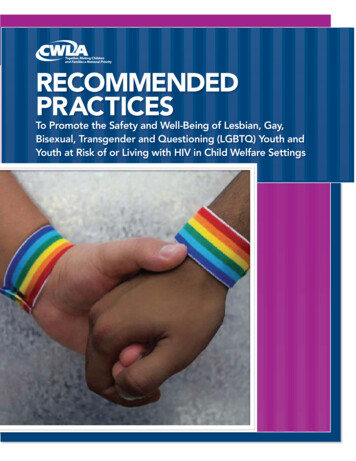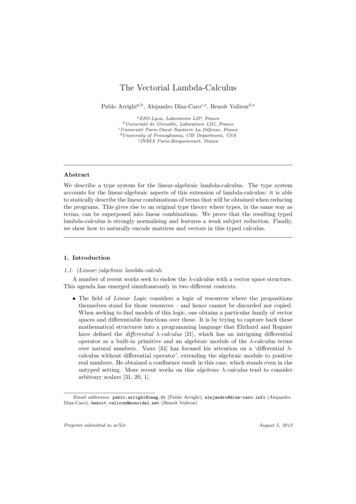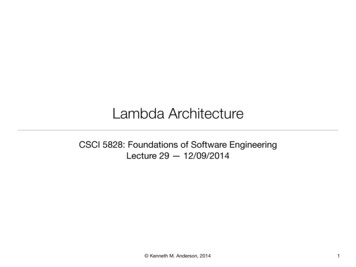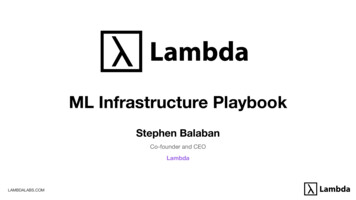
Transcription
RECOMMENDEDPRACTICESTo Promote the Safety and Well-Being of Lesbian, Gay,Bisexual, Transgender and Questioning (LGBTQ) Youth andYouth at Risk of or Living with HIV in Child Welfare Settings
This publication consolidates and summarizesrecommended practices derived from previouspublications of the Child Welfare League of America,the American Bar Association Center on Children andthe Law: Opening Doors for LGBTQ Youth in FosterCare Project, Diane E. Elze, the Family AcceptanceProject, Lambda Legal, Legal Services for Children,Gerald P. Mallon, Robin McHaelen, the National Allianceto End Homelessness, the National Center for LesbianRights, the National Center for Transgender Equality,the National Network for Youth and the Sylvia RiveraLaw Project, among others. We encourage agenciesto refer to the original publications for additionalcontextual information about LGBTQ youth in fostercare as well as detailed commentary supporting thepractices recommended in the following pages.Additional resources include:A Place of Respect: A Guide for Group Care Facilities ServingTransgender and Gender Non-Conforming Youthhttp://www.nclrights.org/site/DocServer/A Place Of Respect.pdf?docID 8301National Recommended Best Practices for Serving LGBTHomeless .pdf?docID 5821A Practical Guide for Youth Workers Serving Lesbian, Gay,Bisexual, Transgender, and Questioning Youthhttp://www.cwla.org/pubs/pubdetails.asp?PUBID 1385Opening Doors for LGBTQ Youth in Foster Care: A Guide forLawyers and ublications/center on children and the law/lgbtq book.authcheckdam.pdfChild Welfare League of America Best Practice Guidelines:Serving LGBT Youth in Out-of-Home acticeslgbtyouth.pdf?docID 1322Getting Down to Basics: Tools to Support LGBTQ Youth in g-down-to-basicsIt’s Your /PublicDocuments/itsyour life.pdfMoving the Margins: Curriculum for Child Welfare Serviceswith Lesbian, Gay, Bisexual, Transgender, and QuestioningYouth in Out-of-Home -the-marginsOut of the Margins: A Report on Regional Listening ForumsHighlighting the Experiences of Lesbian, Gay, Bisexual,Transgender, and Questioning Youth in -the-marginsPublications of Gerald P. Mallon regarding this tmUnderstanding Transgender: Frequently Asked QuestionsAbout Transgender nderstandingTrans.pdfYouth in the Margins: A Report on the Unmet Needs of Lesbian,Gay, Bisexual, and Transgender Adolescents in Foster in-the-marginsCONTENTSPAGESECTION1Purpose2LGBTQ Youth Are Often Underserved and Unsafe in Child Welfare Systems4Leading Child Welfare Professional Organizations Call for Supporting LGBTQ Youth in Care6The Historical Development of Standards of Care for LGBTQ Youth in Child Welfare Systems9Recommended Practices to Promote the Safety and Well-Being of LGBTQ Youth and Youth atRisk of or Living with HIV in Child Welfare Settings17Conclusion
Photos: iStock (cover); Corbis (this page). Models used for illustrative purposes only.PURPOSEThrough these Recommended Practices, theChild Welfare League of America (CWLA)1and co-authors2 seek to provide guidance to theAdministration on Children, Youth and Families(ACYF), state and local child welfare agencies andtheir contract providers on how to fulfill their professionaland legal obligations to ensure safe and proper care consistentwith the best interest and special needs of each and everylesbian, gay, bisexual, transgender or questioning (LGBTQ)child in the child welfare system.3 On April 6, 2011, theACYF Commissioner, Bryan Samuels, issued a memorandumencouraging protection and support of LGBTQ youth infoster care.4 These Recommended Practices elaborate on theprovision of services to LGBTQ youth in the areas of fostercare, child protection, family preservation, adoption and youthdevelopment. They aim to assist state child welfare agencies tomeet the needs of this particularly vulnerable and underservedpopulation by promoting safe, competent and supportivesettings for LGBTQ youth.1 Established in 1920, and headquartered in Washington, DC, CWLA strivesto advance sound public policy on behalf of the more than 3 million abused,neglected and vulnerable children served by its nearly 560 member agencies.CWLA’s mission is to engage people everywhere in promoting the well-being ofall children, youth, and their families, and protecting every child from harm.2 American Bar Association Center on Children and the Law: Opening Doorsfor LGBTQ Youth in Foster Care Project; Diane E. Elze, Associate Professor andDirector of the M.S.W. Program, University at Buffalo School of Social Work;Family Acceptance Project; Lambda Legal; Legal Services for Children; GeraldP. Mallon, Julia Lathrop Professor of Child Welfare, Silberman School of SocialWork at Hunter College of the City University of New York; Robin McHaelen,Executive Director, True Colors; National Alliance to End Homelessness;National Center for Lesbian Rights; National Center for Transgender Equality;National Network for Youth; and Sylvia Rivera Law Project.3 The federally mandated State Plan for Foster Care and Adoption Assistancerequires that there be a case plan for each child placed in the child welfaresystem. The plan must be designed such that “the child’s health and safetyshall be the paramount concern[.]” 42 USC § 671(a)(15)(A)(2011); seealso § 671(a)(22)(2011). The plan must include “a discussion of the safetyand appropriateness of the placement[,]” 42 USC § 675(1)(A)(2011), and“address the needs of the child while in foster care, including a discussion of theappropriateness of the services that have been provided to the child under theplan.” § 675(1)(B)(2011). Additionally, a procedure must be in place for reviewof the case plan on a regular basis, to ensure that the plan remains “consistentwith the best interest and special needs of the child[.]” § 675(5)(A)(2011).4 U.S. Dep’t of Health & Human Servs., Admin. on Children, Youth &Families, Information Memorandum ACYF-CB-IM-11-03, Lesbian, Gay,Bisexual, Transgender and Questioning Youth in Foster Care (Apr. 6, 2011).1
LGBTQ YOUTH ARE OFTENUNDERSERVED AND UNSAFE INCHILD WELFARE SYSTEMSLGBTQ youth are over-represented in child welfaresystems across the country.5 For some LGBTQadolescents in care, their sexual orientation orgender identity and/or expression is the reasonthey may be living out of the home. Familieshostile to their children’s LGBTQ identities may haverejected, abused or neglected them, causing them to enterthe child welfare system in the first place.6 Case workersmay believe that young LGBTQ people in the systemare harder to place in permanent settings or reunify withfamilies, which results in many LGBTQ youth emancipatingfrom care without these important lifelong connections. Ifgiven appropriate support, acceptance and access to copingstrategies, young LGBTQ people demonstrate high levelsof resilience and positive outcomes.7 Conversely, if LGBTQyouth in the child welfare system are given little or no supportby caregivers and child welfare professionals, they face poorprospects of successfully transitioning to adult living andface elevated health and behavioral risks compared to theirnon-LGBTQ peers.8 Research has shown that LGB youthare more likely than their heterosexual peers to be at risk forsubstance use, sexual behaviors that can lead to HIV infectionand other sexually transmitted infections, attempted suicideand violence.9 Community reports show high levels ofvictimization among LGBTQ adolescents10 related to thesocial stigma and harassment they face from their peers andadults in their lives.11 LGBTQ youth who experience thehighest levels of family and caregiver rejection are most at riskfor serious health problems in adulthood.12LGBTQ youth routinely experience harassment and abusein the child welfare system. This includes harassment andvictimization from peers, and may also include sexual abuse.Moreover, many report discrimination, harassment andabusive reactions from child welfare staff and foster parents.They may be subjected to coercive and harmful conversionor reparative therapies attempting to change their sexualorientation or gender identity,13 put in isolation from otheryoung people in congregate care settings, or cycled throughmultiple foster homes when one after another unsuitableplacement turns out to be a poor fit.14 Blatant hostility andverbal abuse are often an accepted aspect of institutionalculture. Because of such treatment, many LGBTQ youth feelforced to hide their sexual orientation or gender identity in5 See id. See also Shannan Wilber, Caitlin Ryan & Jody Marksamer, CWLABest Practice Guidelines for Serving LGBT Youth in Out-of-Home Care 1 (2006)[hereinafter CWLA Best Practice Guidelines]; Child Welfare League of Am. &Lambda Legal Def. & Educ. Fund, Getting Down to Basics: Tools to SupportLGBTQ Youth in Care (2010) [hereinafter Getting Down to Basics], LGBTQYouth Risk Data.6 See Getting Down to Basics, supra note 5, LGBTQ Youth Risk Data.7 See Nat’l Gay & Lesbian Task Force Policy Inst. & Nat’l Coal. for the Homeless,Lesbian, Gay, Bisexual and Transgender Youth: An Epidemic of Homelessness 84-85(2006) (crediting “programs established to work specifically with LGBT homelessyouth” with helping clients “feel good about [their] emerging identit[ies]” andsaving clients’ lives, “getting [them] off drugs, into safe housing and reconnectedwith [their] famil[ies]”) [hereinafter LGBT Youth: An Epidemic of Homelessness];Caitlin Ryan et al., Family Acceptance in Adolescence and the Health of LGBT YoungAdults, 23 J. Child Adolescent Psychiatric Nursing 205, 213 (2010) (“Familyacceptance predicts greater self-esteem, social support, and general health status;it also protects against depression, substance abuse, and suicidal ideation andbehaviors.”).8 See LGBT Youth: An Epidemic of Homelessness, supra note 7, at 41-82.9 Ctrs. for Disease Control & Prevention, Sexual Identity, Sex of Sexual Contacts,and Health-Risk Behaviors Among Students in Grades 9-12 – Youth Risk BehaviorSurveillance, Selected Sites, United States 2001-2009, 60 MMWR Early Release(June 6, 2011); Caitlin Ryan et al., Family Rejection as a Predictor of NegativeHealth Outcomes in White and Latino Lesbian, Gay, and Bisexual Young Adults, 123Pediatrics 346 (2009).10 See LGBT Youth: An Epidemic of Homelessness, supra note 7, at 41-46.11 See Child Welfare League of Am. & Lambda Legal Def. & Educ. Fund, Outof the Margins: A Report on Regional Listening Forums Highlighting the Experiencesof Lesbian, Gay, Bisexual, Transgender, and Questioning Youth in Care 2-3 (2006)[hereinafter Out of the Margins].12 Ryan et al., supra note 7.13 Nat’l Ass’n of Soc. Workers, “Reparative” and “Conversion” Therapies forLesbians and Gay Men (2000); Am. Psychological Ass’n, Appropriate TherapeuticResponses to Sexual Orientation (2009).14 At listening forums for LGBTQ youth in out-of-home care, one teenagershared a story of being beaten by other residents and then told by group homestaff that it was his own fault for being a “faggot.” Another youth told of a fosterfamily that took away her clothes and called her a “dyke.” Out of the Margins,supra.2
order to survive. Others, unable to hide, may run away fromtheir placements and end up on the streets.15treatment for Gender Identity Disorder (GID), given sexsegregated rooming assignments inconsistent with theirgender identities, called by their names assigned at birthrather than their preferred names and forced to dress in waysthat allow no room for their gender expression.17Transgender youth, whose circumstances and needs areparticularly misunderstood, often suffer especially poortreatment in child welfare systems.16 They are regularlytargeted for harassment and assault, denied necessary medical15 LGBT Youth: An Epidemic of Homelessness, supra note 7, at 11-23.16 Getting Down to Basics, supra note 5, Working with Transgender Youth.17 See id.; Jody Marksamer et al., A Place of Respect: A Guide for Group CareFacilities Serving Transgender and Gender Non-Conforming Youth (Spring 2011)[hereinafter A Place of Respect].Photo: iStock. Models used for illustrative purposes only.“LGBTQ YOUTH WHOEXPERIENCE FAMILYAND CAREGIVERREJECTION ARE MOSTAT RISK FOR SERIOUSHEALTH PROBLEMS INADULTHOOD.”3
LEADING CHILD WELFARE PROFESSIONALORGANIZATIONS CALL FOR SUPPORTINGLGBTQ YOUTH IN CAREAmerican Psychological Association advises parents, guardians,young people and their families to avoid sexual orientationtreatments that portray homosexuality as a mental illness ordevelopmental disorder and instead to seek psychotherapy andsupportive services for LGBTQ youth that provide accurateinformation on sexual orientation, decrease rejection andincrease family and school support.2118 Getting Down to Basics, supra note 5, What the Experts Say: Position & PolicyStatements on LGBTQ Issues from Leading Professional Associations.19 “NASW recognizes that there is considerable diversity in gender expressionand identity among our population and believes that people of diverse gender—including those sometimes called ‘transgender’—should be afforded the samerespect and rights as any other person.” Nat’l Ass’n of Soc. Workers, Abstract,Transgender and Gender Identity Issues, Social Work Speaks (2009) [hereinafterNASW Transgender]. NASW also states “that same-gender sexual orientationshould be afforded the same respect and rights as other-gender sexual orientation.”Nat’l Ass’n of Soc. Workers, Abstract, Lesbian, Gay and Bisexual Issues, SocialWork Speaks (2009).20 Am. Psychiatric Ass’n, Psychiatric Treatment and Sexual Orientation. PositionStatement (1998). See generally Am. Psychological Ass’n, Abstract, Resolutionon Appropriate Affirmative Responses to Sexual Orientation Distress and ChangeEfforts [hereinafter Appropriate Affirmative Responses]; Am. Psychoanalytic Ass’nPosition Statement on Reparative Therapy (1999) (“Psychoanalytic techniquedoes not encompass purposeful efforts to ‘convert’ or ‘repair’ an individual’ssexual orientation. Such directed efforts are against fundamental principles ofpsychoanalytic treatment and often result in substantial psychological pain byreinforcing damaging internalized homophobic attitudes.”); Am. PsychiatricAss’n, Therapies Focused on Attempts to Change Sexual Orientation (Reparativeor Conversion Therapies) (2011) (“APA recommends that ethical practitionersrefrain from attempts to change individuals’ sexual orientation[.]”).Consistent with the professional standards governing thisfield, LGBTQ youth should receive culturally competentchild welfare services, including: positive youth developmentprograms; LGBTQ-affirming preventive services; fostercare services focused on permanency; safe foster placementswhere an LGBTQ youth’s sexual orientation, gender identityand gender expression are respected; referrals to LGBTQcompetent physical and mental health care providers;LGBTQ-affirming mentors and role models who can providelong-term sources of support in their lives; and transitionalservices that help establish independent life skills, takinginto account the specific challenges faced by LGBTQ people21 Appropriate Affirmative Responses, supra note 20.4Photo: Corbis. Models used for illustrative purposes only.The overwhelming consensus among the country’sleading and most respected child welfare, socialscience and medical health organizations is thatLGBTQ youth and adults deserve respect andsupport from professional service providers. TheNational Association of Social Workers (NASW), the AmericanPsychological Association (APA), the American Academy ofPediatrics (AAP) and the American Academy of Child andAdolescent Psychiatry (AACAP) oppose discrimination againstLGBTQ youth.18 These professional organizations agree thatall youth should be afforded the same treatment and respectregardless of sexual orientation or gender identity.19 Specifically,the major professional associations caution against use oftherapies to attempt to change sexual orientation. For example,the American Psychiatric Association “opposes any psychiatrictreatment, such as reparative or conversion therapy, whichis based upon the assumption that homosexuality per se is amental disorder or based upon the a priori assumption that thepatient should change his/her homosexual orientation.”20 The
Photo: Corbis. Models used for illustrative purposes only.because of pervasive discrimination.22 By implementing theseRecommended Practices, state child welfare agencies will helpremedy neglect suffered by LGBTQ youth, as well as preventabuse and improve outcomes for these vulnerable young people,consistent with professionally accepted standards of care.“LGBTQ YOUTHAND ADULTSDESERVE RESPECTAND SUPPORT FROMPROFESSIONALSERVICEPROVIDERS.”22 CWLA Best Practice Guidelines, supra note 5.5
THE HISTORICAL DEVELOPMENT OFSTANDARDS OF CARE FOR LGBTQYOUTH IN CHILD WELFARE SYSTEMSIn the 1990s, Lambda Legal began a national initiativeto focus on the needs of LGBTQ youth experiencingdiscrimination in foster care and juvenile justice systems.In 2001, Lambda Legal published Youth in the Margins:A Report on the Unmet Needs of Lesbian, Gay, Bisexualand Transgender Adolescents in Foster Care.23 The report surveyedpolicies and practices in 14 states and found that LGBTQ youthwere neglected and marginalized by the state child welfare systemscharged with safeguarding them. While many child welfareprofessionals recognized and endeavored to address the plight ofthese young people, they lacked best practice guidelines, trainingand resources to provide competent services to the LGBTQyoung people in their care. Many of these gaps have been filledin the ensuing years with the following resources.the experiences of gay and lesbian youth in the child welfaresystem, with recommendations to social work practitioners andpolicymakers on providing competent child welfare services toLGBTQ youth. In 2002, Mallon co-authored There’s No PlaceLike Home: Safety, Permanency, and Well-being for Lesbian andGay Adolescents in Out-of-Home Care, a publication examiningthe challenges of ensuring permanency, safety and well-being forLGBT youth.27 Mallon has also written extensively about socialwork practice with transgender and gender-variant children.28In 2002, Legal Services for Children and the National Centerfor Lesbian Rights (NCLR) launched the Model StandardsProject to develop and disseminate model professional standardsgoverning services to LGBTQ youth in out-of-home care. TheModel Standards Project, in partnership with CWLA, publisheda resource entitled Best Practice Guidelines: Serving LGBT Youthin Out-of-Home Care (CWLA Best Practice Guidelines) in 2006,the first set of comprehensive professional guidelines for howchild welfare and juvenile justice professionals can best serveLGBTQ youth in state care. The CWLA Best Practice Guidelinesinclude accurate, up-to-date information about the best practicesfor supporting positive youth development; meeting the healthand educational needs of LGBTQ youth; managing confidentialinformation; and creating safe, respectful and nurturing homeand social environments for LGBTQ youth in care.29In 1991, CWLA published Serving Gay and Lesbian Youths: TheRole of Child Welfare Agencies, Recommendations of a Colloquium,one of the first publications addressing obstacles to providingquality services to LGBT youth in foster care and makingrecommendations for policy, practice and advocacy to bettermeet their needs.24 In subsequent years, Gerald P. Mallon,Julia Lathrop Professor of Child Welfare at the SilbermanSchool of Social Work at Hunter College and ExecutiveDirector of the National Resource Center for Permanency andFamily Connections, published multiple books and articleson issues faced by LGBTQ youth in the child welfare systemand suggestions for improving agency environments andestablishing LGBT-affirming child welfare services.25 In 1998,Mallon published We Don’t Exactly Get the Welcome Wagon: TheExperiences of Gay and Lesbian Adolescents in New York City’sChild Welfare Systems,26 the first comprehensive research onIn 2002, social work experts Caitlin Ryan and Rafael Díazdeveloped the Family Acceptance Project, a community research,intervention, education and policy initiative to decrease majorMallon, Let’s Get This Straight: A Gay and Lesbian Affirming Approach to ChildWelfare (2000).27 Gerald P. Mallon et al., There’s No Place Like Home: Safety, Permanency andWell-Being For Lesbian and Gay Adolescents in Out-of-Home Care, 80 ChildWelfare 78 (2000).28 See Social Services With Transgendered Youth, Gerald P. Mallon ed. (1999);Teresa DeCrescenzo & Gerald P. Mallon, Transgender Children and Youth: AChild Welfare Practice Perspective, 85(2) Child Welfare 215 (2006); Social WorkPractice with Lesbian, Gay, Bisexual and Transgender People, Gerald P. Mallon ed.(2d ed. 2008).29 CWLA Best Practice Guidelines, supra note 5.23 Lambda Legal Def. & Educ. Fund, Youth in the Margins: A Report on theUnmet Needs of Lesbian, Gay, Bisexual and Transgender Youth in Foster Care(2001).24 Child Welfare League of Am., Serving Gay and Lesbian Youths: The Role ofChild Welfare Agencies, Recommendations of a Colloquium (1991).25 See http://www.garymallon.com/publications.htm.26 Gerald P. Mallon, We Don’t Exactly Get the Welcome Wagon: The Experiencesof Gay and Lesbian Adolescents in Child Welfare Systems (1998); see also Gerald P.6
Photo: Corbis. Models used for illustrative purposes only.health and related risks for LGBTQ youth, such as suicide,substance abuse, HIV and homelessness by emphasizing theneed for familial support.30 The Family Acceptance Project hasdelivered the first major serial studies of parents’ and caregivers’reactions and adjustment to adolescents’ coming out processesand LGBTQ identities, and is advancing a family-relatedintervention approach to help families increase support andpromote the well-being of their LGBTQ children. The FamilyAcceptance Project’s intervention model uses a behavioralapproach to help ethnically and religiously diverse familiesreduce their LGBTQ children’s risk of suicide, depression,substance abuse, HIV, homelessness and placement in custodialcare, while respecting each family’s individual values. This workis being conducted in English, Spanish and Chinese with familiesfrom all ethnic backgrounds,including immigrant and verylow income families, and thosewhose children are in foster careand juvenile justice facilities.welfare community with tools, resources and support forimproving outcomes for LGBTQ youth in foster care.33 In2010, ABA Opening Doors for LGBTQ Youth in Foster CareProject published It’s Your Life, a guide to help LGBTQ youthunderstand what to expect in the child welfare legal system.34NASW and Lambda Legal partnered in 2009 to create Movingthe Margins: Training Curriculum for Child Welfare Services withLGBTQ Youth in Out-of-Home Care.35 This train-the-trainermanual leads participants through a series of learning labs,discussion sessions and role-playing activities to help them betterunderstand the challenges faced by LGBTQ youth in out-ofhome care systems and to learn strategies to provide services tothis population.In 2009, the National Allianceto End Homelessness, LambdaLegal, the National Network forYouth and NCLR co-authoredthe National Recommended BestPractices for Serving LGBT HomelessYouth,36 a policy brief that providesan overview of homelessnessamong LGBTQ youth and makesrecommendationstoserviceproviders about how to improvepractice, organizational cultureand residential services.In 2006, CWLA, with partnerorganization Lambda Legal,released Out of the Margins:A Report on Regional ListeningForumsHighlightingtheExperiences of Lesbian, Gay,Bisexual,TransgenderandQuestioning Youth in Care.31This report summarized thefindings of listening forums heldaround the nation, attended byrepresentatives from state andprivate child welfare agencies,mental health experts, lawyers,judges and LGBTQ youth in care,on the experiences of LGBTQ youth and gaps they experiencedin care and services. That same year, CWLA and Lambda Legalalso released Getting Down to Basics: Tools to Support LGBTQ Youthin Care,32 a toolkit that offers practical information and resourcesfor youth in care, foster and adoptive parents, professionals andagencies in child welfare and juvenile justice systems.In 2010, CWLA also released anew, revised edition of LGBTQYouth Issues: A Practical Guide forYouth Workers, bringing recentresearch and clinical practiceregarding LGBTQ youth intofocus for all kinds of youth-serving professionals. This book,by Gerald P. Mallon, provides a combination of practicaltips, research findings and personal vignettes (where theyouth are able to speak for themselves) to guide workerswho want to help LGBTQ youth confront challenges withtheir families, at school, in out-of-home care or in the widerIn 2008, the American Bar Association (ABA) Center onChildren and the Law: Opening Doors for LGBTQ Youthin Foster Care Project published Opening Doors for LGBTQYouth in Foster Care, intended to provide the legal and child33 Mimi Laver & Andrea Khoury, Am. Bar Ass’n. Ctr. on Children & the Law,Opening Doors for LGBTQ Youth in Foster Care (Claire Chiamulera ed., 2008).34 Krishna Desai, Mimi Laver & Andrea Khoury, Am. Bar Ass’n. Ctr. onChildren & the Law, It’s Your Life (2010).35 Diane Elze & Robin McHaelen, Nat’l Ass’n of Soc. Workers & LambdaLegal, Moving the Margins: Training Curriculum for Child Welfare Services withLGBTQ Youth in Out-of-Home Care (2009).36 Nat’l Alliance to End Homelessness, Lambda Legal, Nat’l Network for Youth& Nat’l Ctr. for Lesbian Rights, National Recommended Best Practices for ServingLGBT Homeless Youth (2009).30 The Family Acceptance Project, http://familyproject.sfsu.edu/ (last updatedDec. 1, 2010).31 Out of the Margins, supra note 11.32 Getting Down to Basics, supra note 5.7
community. New in this editionare a chapter on transgenderyouth issues, a chapter on otherspecial populations of LGBTQyouth and specially highlightedsections in each chapter thatanswer the question, “WhatCan Youth Workers Do?”in this area, offering an array ofresources for LGBTQ youth andthose who work with them.39Child welfare systems acrossthe country are encouraged toutilize these resources to assistin permanency achievement,placement stability and a widerange of other foster care andwell-being issues.Most recently, in 2011, theSylvia Rivera Law Projectand NCLR created A Place ofRespect: A Guide for Group CareFacilities Serving Transgender andGender Non-Conforming Youth.37Thiscompilationprovidescomprehensive guidance andmodel policies for the treatmentof transgender and gender nonconforming youth in detentioncenters, correctional facilities,group homes and other groupcare facilities.Additionally, the U.S. Department of Health and HumanServices, through the Children’s Bureau of the Administrationfor Children and Families (ACF), established several Trainingand Technical Assistance Networks (T&TA Networks) toprovide assistance to states and tribes in improving child welfaresystems.38 These T&TA Networks also work to ensure thesafety, permanency and well-being of children and families byoffering training, technical assistance, research and consultation.39 Nat’l Res. Ctr. for Permanency & Family Connections, LGBTQ Issues &Child Welfare, http://www.hunter.cuny.edu/socwork/nrcfcpp/info services/lgbtq-issues-and-child-welfare.html (last updated Aug. 24, 2011).40 City of New Orleans, Human Servs. Dep’t, Youth Study Ctr., Policy No.12.3, Non-Discriminatory, Developmentally-Sound Treatment of Lesbian, Gay,Bisexual and Transgender (LGBT) Youth (2011); N.Y.C. Admin. for Children’sServs., Policy No. 2011/05, Promoting a Safe and Respectable Environment forLesbian, Gay, Bisexual, Transgender and Questioning (LGBTQ) Youth and theirFamilies Involved in the Child Welfare System; and Guidelines Promoting a Safe andRespectable Environment for Lesbian, Gay, Bisexual, Transgender and Questioning(LGBTQ) Youth and their Families Involved with DYFJ (2011); State of Cal.Health & Human Servs. Agency, Dep’t of Social Servs., All County InformationNotice I-81-10, Serving Lesbian, Gay, Bisexual, Transgender and Questioning(LGBTQ) Youth, LGBTQ Caregivers and LGBT Prospective Foster and AdoptiveParents (2010); State of Ill., Dep’t of Children & Family Servs., Procedures 302.Appendix K, Support and Well-Being of Lesbian, Gay, Bisexual, Transgender andQuestioning (LGBTQ) Youths (2009); State of N.Y., Office of Children & FamilyServs., PPM 3442.00, Lesbian, Gay, Bisexual, Transgender and Questioning Youth(2008); S.B. 518, 2007 Leg., Reg. Sess. (Cal. 2007); State of Haw., Dep’t ofHuman Servs., Office of Youth Servs., Haw. Youth Correctional Facility, PolicyNo. 1.43.03, Non-Discriminatory, Developmentally-Sound Treatment of Lesbian,Gay, Bi-Sexual and Transgender (LGBT) Youth (2007); State of Conn., Dep’t ofChildren & Families, Policy No. 30-9, Non-Discrimination of LGBTQI Individuals(2004); A.B. 458, 2003 Leg., Reg. Sess. (Cal. 2003).The National Resource Center for Permanency and FamilyConnections (NRCPFC) offers onsite technical assistance andin-depth information services in collaboration with familypartners to assist in the implementation of new strategies,expanding knowledge, increasing competencies and expandingcommitment to family-centered practice by child welfareprofessionals at all levels. The NRCPFC has inco
of Lesbian, Gay, Bisexual, Transgender, and Questioning Youth in Care 2-3 (2006) [hereinafter Out of the Margins]. 12 Ryan et al., supra note 7. 13 Nat'l Ass'n of Soc. Workers, "Reparative" and "Conversion" Th erapies for Lesbians and Gay Men (2000); Am. Psychological Ass'n, Appropriate Th erapeutic










